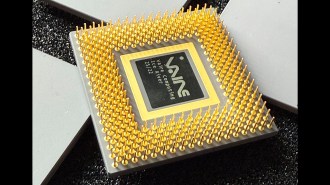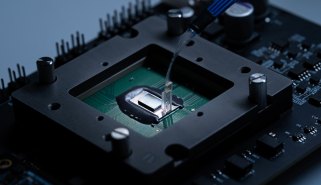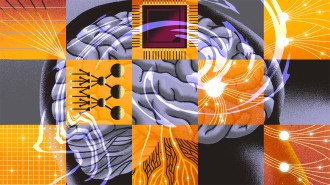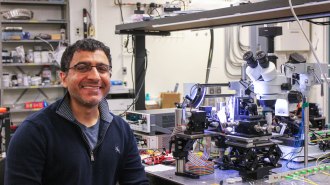In the animated film Monsters, Inc., James P. Sullivan is an 8-foot-tall monster who’s covered from head to toe in a luxurious powder-blue pelt with faint red polka dots. What makes him stand out in the already eye-popping domain of computer animation is the independent motion of every single one of the 3.2 million hairs on his body. The result is a coat




of animated fur that looks soft enough to stroke and behaves with a remarkable degree of realism.
Using the mathematics that accounts for the behavior of miniature systems of springs and weights, computer scientists at Pixar Animation Studios in Emeryville, Calif., which released the film last November, devised an efficient way to represent a few thousand of the monster’s hairs. Computers then calculated how those representative strands would respond to the motions of the monster’s massive body and to gravity, wind, and other conditions of the animated environment. With these few thousand strands serving as guideposts, the computer then interpolated the behavior of the millions of strands between them.
In another 2001 film, Pearl Harbor, real and animated warplanes and ships are indistinguishable as they mingle on the screen. None of the real planes crash, but the animated ones do. The fake planes were rendered graphically using so-called rigid-body models, which essentially let the animators build structures–and blow them up–using a virtual kit of wing and fuselage parts. The puffs of flak that dot the sky in some scenes emanated from a computer simulation of fluid dynamics, replete with equations for heat buildup and pressure waves that add to the verisimilitude.
In those films and many more, including Stuart Little, The Perfect Storm, and Shrek, powerful, physics-based computer simulations are vastly expanding the range of realistic effects that can be brought to the screen. Leaps in computing power and new algorithms for generating simulated action are also transforming the $7-billion computer-game industry.
The physics being simulated “was all basically solved like 300 years ago,” notes Chris Hecker, a game developer in Oakland, Calif. But getting the simulations to play out accurately and efficiently for the countless phenomena in movie and game scenes is a hot area of computer-science research (SN: 4/10/99, p. 232: http://www.sciencenews.org/sn_arc99/4_10_99/bob1.htm). “As someone watching, you take them completely for granted, but they’re incredibly complicated things to get looking right,” says animation researcher Nick Foster of PDI Dreamworks in Palo Alto, Calif., the studio that created Shrek, Antz, and numerous short animated films and commercials.
Animating an entire world
In hand-drawn animated films dating back to the 1930s such as Walt Disney’s Dumbo, Snow White and the Seven Dwarves, and Sleeping Beauty, artists created two-dimensional fantasy worlds by drawing them on sheets of paper or celluloid. Now, armed with computers, animators can digitally make characters, machines, and environments with three-dimensional identities. Released in 1995, the first computer-animated feature film, Pixar’s Toy Story, was rendered completely in three dimensions.
Building a simulated 3-D world can be both a boon and a curse. Thoroughly simulating characters and their surroundings makes it possible to look at them from any angle and to manipulate them via computer commands. On the other hand, nearly everything in every scene must have carefully defined physical characteristics and boundaries.
Sometimes it doesn’t work out that way, especially when parts of the scene move out of view. For instance, Foster notes, “in computer-animation-land, it’s easy for an animator to put part of a character’s arm through his stomach,” when that’s not the intention.
Then, the physics goes haywire. During the making of Monsters, Inc., such a boundary problem at first turned the clothing on some characters into an unrecognizable tangle. “We had days when we doubted if this could be solved,” recalls David Baraff of Pixar.
Baraff, who was a professor of robotics at Carnegie Mellon University in Pittsburgh before making the switch to entertainment, hasn’t yet revealed how the problem was resolved. However, Pixar has applied for a patent on the solution and may present a report on it next summer at the annual meeting known as Siggraph, where computer graphics specialists exchange ideas, Baraff notes.
As animation pioneers experimented with computer-calculated 3-D motion, starting in the 1960s, they first overcame the challenges of automating the movement of simple, solid objects, like a ball flying through the air. The physics and math are simple enough for a computer to easily calculate a moving object’s new position for each frame (SN: 11/24/90, p. 328). That’s every 1/24 of a second for a film and as fast as every 1/60 of a second for a game.
The same Newtonian laws of motion apply to collisions of solid objects. These calculations rapidly become enormous computational tasks as the number and complexity of colliding objects grow, but they already have become routine tools for making today’s animated productions.
Some everyday phenomena, such as moving fluids, act in an even more complicated and difficult-to-compute manner. To make images of them look real, animators have turned to more-specialized tools. “For amorphous things like water, clouds, smoke, and pieces of Jell-O, there seem to be two approaches,” notes ex-academic Hugh Reynolds, who cofounded the physics-based animation company Havok in Redwood City, Calif., in 1998. “One [approach] is to try to come up with a big, mysterious equation that represents all this stuff. The other is to think of it as a big cluster of chunks,” he explains. The latter–a spinoff from the field known as computational fluid dynamics–is the more practical of the two, and the one that animation scientists have embraced.
Consider the huge waves in The Perfect Storm, the spurting mud blobs and lava in Shrek, and other fluid effects. To simulate these, animation scientists have adapted methods created by physicists and engineers for breaking up the space occupied by a fluid into tiny volumes, each of which can be processed in a computer.
For each volume and each frame, a computer calculates the forces between the volume and its neighbors, as well as other forces, such as gravity. With those results, it then determines the velocity and pressure that the fluid would have at the center of each volume.
To depict motion, the computer treats the fluid space as if thousands of particles were sprinkled into component volumes at random locations. The machine next calculates intermediate velocities at those locations and figures out where the particles would have moved to by the next frame.
The computer then uses those new coordinates “to build a smooth, implicit surface” that portrays the fluid, says Foster, a pioneer of fluid-animation techniques in film. That last step is “pretty tricky mathematically,” he notes. The process of calculating all the forces, pressures, velocities, and particle trajectories is then repeated frame by frame as the action advances.
Although real fluids don’t act like tens of thousands of individual volumes jostling each other, the approximation yields realistic-looking flows.
Most recently, Foster says, his team has added more physical nuance to the simulations by switching from a uniform grid of volumes filling the fluid space to one in which, nearest the surface, the volumes grow smaller and more densely packed. That enables the computer to capture tiny ripples, swirls, and other surface details beyond the gross movements of the fluid.
Carrying the technique to an extreme, researchers at the Georgia Institute of Technology in Atlanta have recently extended physics-based animation to simulating explosions. That’s not yet done in the film industry, where movies such as Pearl Harbor convincingly depict blasts by combining footage of real explosions with manually generated computer graphics.
Gary D. Yngve, now a graduate student at the University of Washington in Seattle, and his colleagues have built upon equations and algorithms borrowed from scientific computational fluid dynamics. Their technique models the shock waves generated by a detonation and can depict the interaction between the blast and solid objects that may either shape the explosion or be shattered by it.
Among scientists pushing the envelope of computer animation, most focus on its visual aspects, but others are tuning in to sounds. James F. O’Brien of the University of California, Berkeley, who was also a coauthor of the explosion-simulation research, and his colleagues at Princeton University have developed a computer program that calculates vibration patterns generated in the surfaces of objects during collisions and other mechanical interactions. The program then simulates the pressure waves–that is, the sounds–produced as the vibrating surface shakes the air. The researchers described the novel method last August at the SIGGRAPH conference in Los Angeles.
Since the streamlined technique adds only about 1 percent of additional computation time to animation, game developers, who do not tolerate slowed-down action, may be interested in using the approach says O’Brien. Games now rely on prerecorded audio tracks, which can quickly get boring. “After a while, people just turn off the audio,” he notes,
One thing that computers still can’t simulate adequately with equations is natural bodily motions, such as walking and running, by human or animal characters. “Our mathematics is not sophisticated enough yet,” says Jovan Popovic of the Massachusetts Institute of Technology. “The motion of creatures is a lot harder than the passive simulations, such as fluid dynamics.”
Moreover, people are such innately keen observers of human and animal motion that the simulations have to be especially realistic.
To make their simulated characters move, animators use computer programs that represent the characters as a virtual Tinkertoy kit of body parts. A grid of numbers, called a matrix, defines how each joint moves in space and what its limitations are.
To create believable motion, animators sometimes use so-called motion capture, in which footage of real people or animals in action serves as a template.
Mostly, however, the animators just use the computer as a tool to draw the action frame by frame. Like puppet masters, they adjust controls provided by their computer programs to move virtual body parts, with additional refinements for the soft tissues of the face.
“Our characters have 700 to 800 animation controls,” Foster notes. An eyebrow, for instance, may be allotted up to six adjustments for some characters to create realistic arching and wrinkling, he says.
The director’s always right
Films tell stories. A top goal of animation scientists is to open realistic simulations to the creativity of the head raconteur–the director. “In film, you can overuse these [physics-simulation] tools and destroy the fundamental storytelling,” says Seamus Blackley, a former particle physicist who heads computer game-console development for Microsoft Corp. in Redmond, Wash.
Whereas water flowing in some scientific simulations needs only behave like real water, water in an animated film may have to scowl at someone or take on the shape of a horse or dance along a diving board. “The huge challenge is making these things what we call ‘directable’,” says Baraff.
For simple animations, Popovic and his colleagues have recently demonstrated one way to that end. The researchers were considering what happens after a mug drops onto a table. Suppose the director wants it to land upright, but in an accurate physics simulation, the vessel always ends up on its side.
By adding subtle unevenness to what had been a perfectly flat table top, the scientists showed that they can create conditions in which the mug bounces a few times and then settles upright. Moreover, they’ve devised a way to enable an animator to make incremental adjustments in the trajectory of animated motion, including collision-related motions that gradually reshape the original simulation.
“Our mathematical models of collisions are all approximations of what happens in the real world anyway, so we can vary them to our benefit,” Popovic explains. The technique also works more rapidly than approaches in which researchers fix the final outcome from the start and then compute backwards, sometimes for hours, to find a physically sound sequence of actions, he adds.
Playing with physics
Unlike films, computer games have always been simulations. What’s new is the raw computing power in the latest game consoles and the advent of more efficient physics engines–the science-based programs that produce all of the action.
Whereas typical games play clips of prerecorded animation to generate car crashes, football tackles, or other events, a game with a good physics engine “empowers the user to have a real effect on the virtual world,” says David Wu, founder of Pseudo Interactive, a Toronto-based game-development company.
Even if a game has a warped physical reality compared with our everyday world, simulating the physics helps ensure that the responses of that realm are consistent and believable. “Physics is one of the great tools in our arsenal to create this consistency,” says Microsoft’s Blackley.
A new game called Cel Damage, for example, combines physics muscle with the look and brutal zaniness of a Roadrunner cartoon. Hecker, who is also editor-at-large of Game Developer Magazine, describes Cel Damage as “state-of-the-art for computer-game physics.”
Wu’s company created the game to run on Microsoft’s X-box, a console launched last November. With this game, a player can attack opponents with an array of weapons, including giant hammers, harpoons, and freezing rays that make an enemy turn brittle enough to shatter into chunks.
To keep the game’s action consistent with players’ physical intuitions, the game’s physics engine calculates all the relevant interactions. But to make the action also outlandishly cartoony, the computer plays loose with some of the numbers used in its engine.
For instance, it assigns cars the elasticity of balloons and makes hammers as heavy as anvils. When a hammer blow hits a car, the vehicle temporarily squashes flat–cartoon fashion–and then springs back again. Overweight harpoons hit like missiles, powerful enough to penetrate steel.
It’s all in the parameters of the equations.
For game developers and filmmakers who know how to manipulate such representations of physical reality, even the immutable laws of physics can give wings to their fancy.







